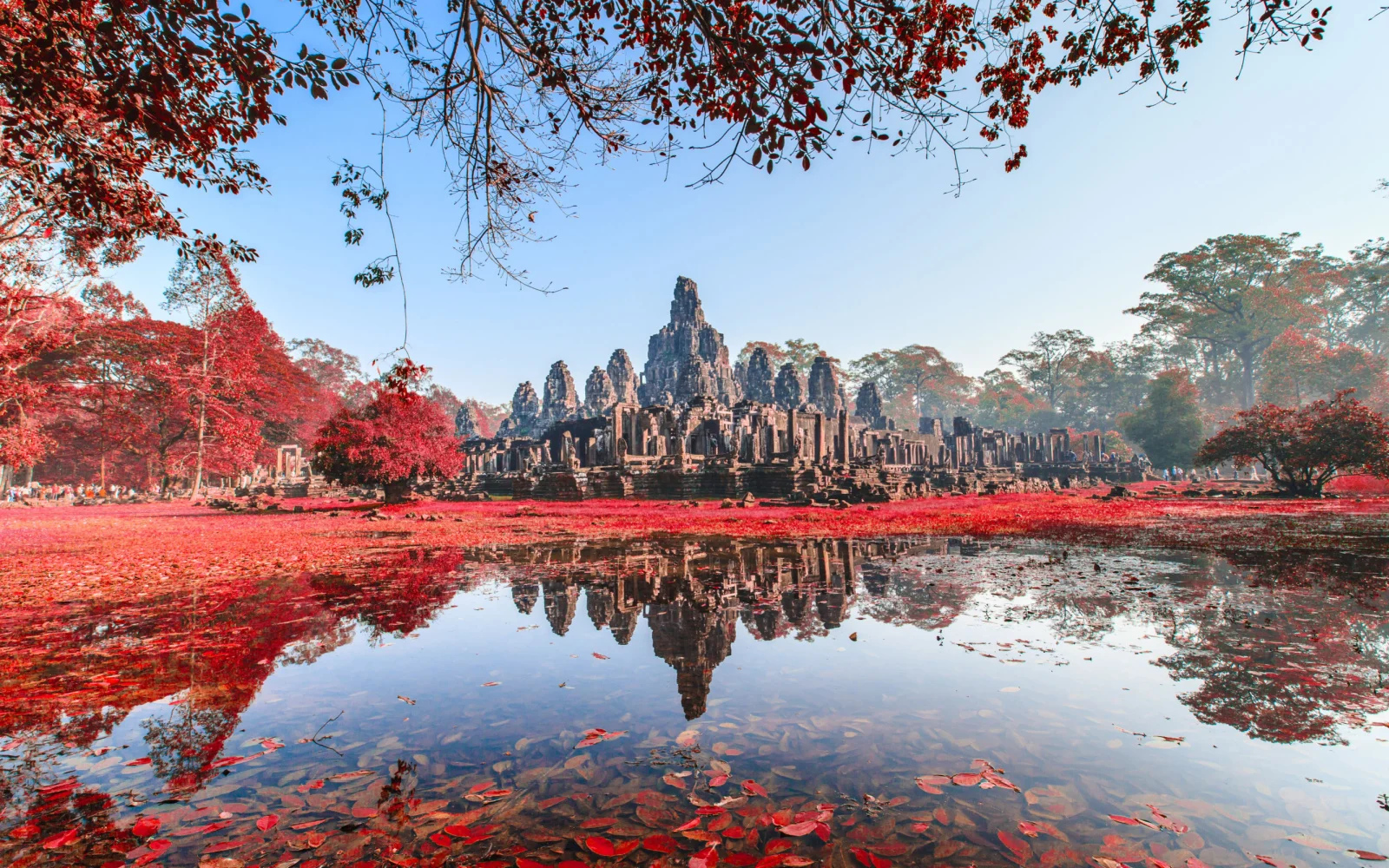What's the best time to visit Cambodia?
The best time to visit Cambodia is during the dry season from November to April, with November and December offering cooler temperatures and festive events like the Angkor Wat International Half Marathon.
February and March are the least humid months, ideal for exploring, although tourist areas get crowded due to Chinese and Vietnamese New Year celebrations. Book in advance for the festive period, especially around Christmas and New Year, to avoid the rush.
A country with two main seasons, Cambodia will either drench you with water or welcome you with devilishly high temperatures. But picking the wrong time to go will not only ruin your trip, it can be downright dangerous. But don’t worry — we’ll show you when to visit and more below.
The Overall Best Time to Visit Cambodia
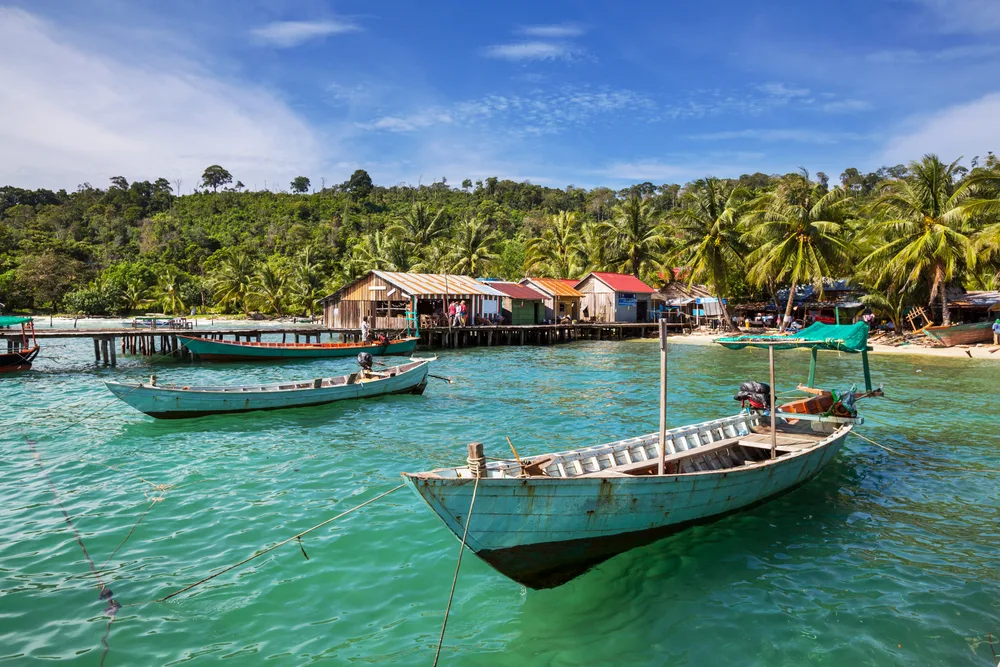
Galyna Andrushko/Shutterstock
The best time to visit Cambodia is during the dry season, which runs from November to April. During this time, the country sees average temperatures in November, fluctuating between 85°F and 72°F.
November is the coldest month of the year, if we can ever refer to such temperatures as cold at all. December also has tropical temperatures with an average high of 86°F and an average low of 71°F.
It also has the shortest days of the entire year on average, at around 11 hours. During the festive period, the prices here are daylight robbery.
Christmas and New Year are tourist peak times, especially in places such as Angkor, and top-notch beach resorts are always reserved. So make sure to book well in advance if you’re planning on visiting Cambodia during this period.
A cool December event taking place in Cambodia is the Angkor Wat International Half Marathon. Runners can pick between several run options. Like December, January is a hot, dry season month with temperatures varying between 71.4°F and 88.7°F.
February is the month with the least rain in the capital. It sees temperatures ranging between 91°F and 73.4°F. After that, March welcomes visitors with temperatures hovering around 94.8°F on average during the day and 75.4°F at night.
With a relative humidity of around 71%, February and March are the least humid months. March is also one of the hottest Phnom Penh months. The January–March period is also a busy period festivity-wise.
Chinese and Vietnamese New Years’ celebrations mark this period, so places such as Siem Reap, the South Coast, and Phnom Penh see an influx of visitors. Be ready for some serious crowds, dragon-like street dances, and an unlike-anywhere-else type of festive cheer.
Cheapest Time to Visit Cambodia
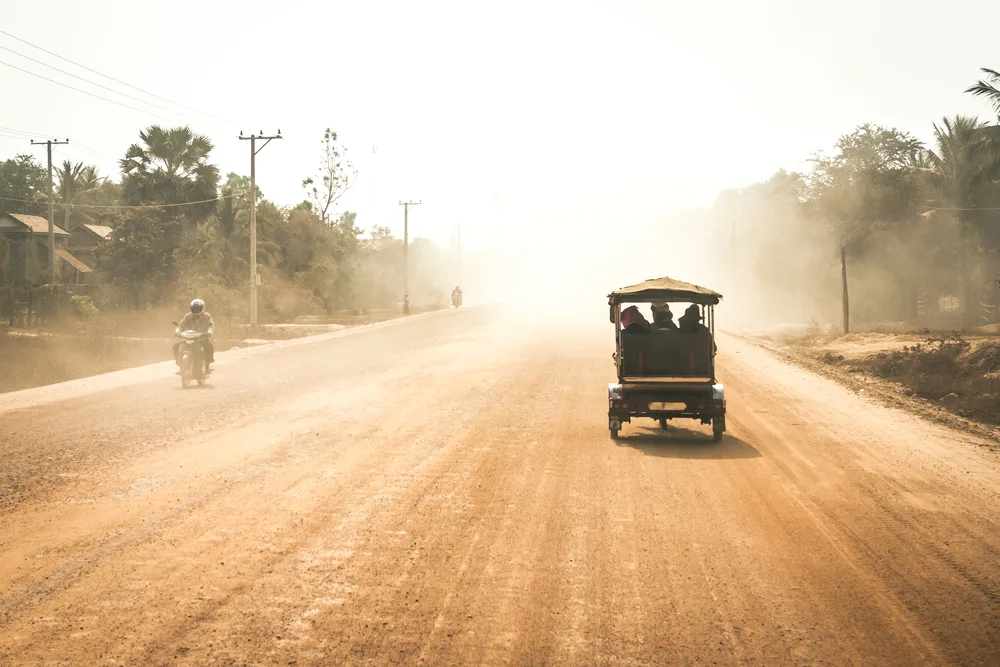
Jakub Barzycki/Shutterstock
The cheapest time to go to Cambodia is from April to June. Unfortunately, the shoulder season means bad weather (scorching temperatures), hence the lower prices and discounted accommodation deals.
April visitors should get ready for temperatures fluctuating between 94.8°F and 77°F. Together with March, April is one of the hottest months. May is another hot month, with temperatures ranging between 93.7°F and 77.5°F.
Finally, June sees temperatures varying between 77°F and 92.3°F. It’s also the month with the longest days — there are around over 12 hours of daylight.
While the temperatures may be boiling, the plethora of events available during that period can help you freshen up. For the mid-April period, we recommend the Chaul Chnam Khmer event, the famous three-day celebration of Chaul Chnam Khmer (Cambodian New Year).
Locals clean their homes and exchange presents. The Chat Preah Nengkal, or the Royal Ploughing Ceremony, is a fantastic event as well.
Led by the Cambodian royal family members, the Chat Preah Nengkal is an ancient agricultural celebration that marks the start of the rice-growing season. In short, the ritual is as follows: it is believed that royal oxen predict the farming conditions for the upcoming year when presented with feed.
Finally, if you happen to be in Cambodia in May or June (the festival takes place on the eighth day of the fourth moon), you have to join the celebration of Buddha’s birth.
This is known as Buddha Day, or Visakha Puja. By paying homage to Buddha, travelers get to experience a tradition different from theirs and explore how distinct cultures pay their respects to notable individuals.
Least Busy Time to Visit Cambodia
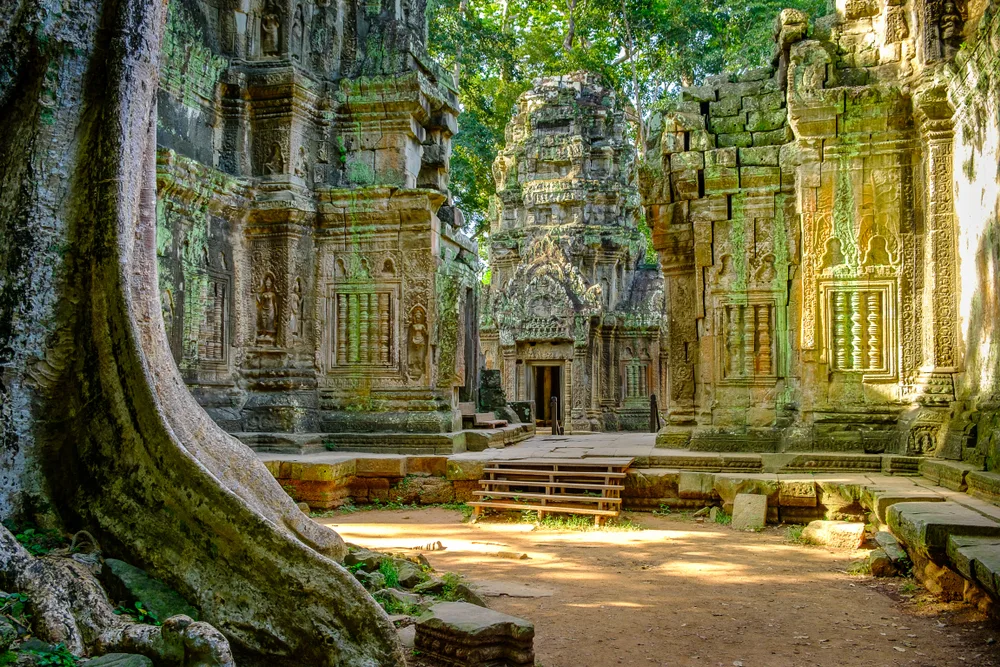
Mark R Croucher/Shutterstock
The least busy time to visit Cambodia is in September or October. School season is on for the majority of places in the world, so families would have ended their visits by the end of August.
Those like you looking for a way to beat the crowds, though, should take advantage of these two months. However, there’s one caveat: fewer tourists visit Cambodia in September and October because these two months are — hands down — the rainiest.
Downpours are more substantial, and roads can be heavily impacted, which makes flooding a strong possibility. In September, the temperatures range between 90.1°F and 75.5°F.
It’s also the month with the least sunshine, with approximately 4.3 hours. October, although another tropical fall month, is the month with the heaviest rainfall (there’s rain for 24 days on average).
With a relative humidity of around 84%, these two months are the most humid months. However, festivals such as the Pchum Ben (the Festival of the Dead) make everything better.
This festival, in particular, is very similar to how the Christian’s All Souls’ Day is celebrated. Pchum Ben lasts for a few days and is known for a lot of chanting, ceremonies, and lively local temples.
Another notable November is the Bon Om Tuk, or the Water Festival, which celebrates King Jayavarman VII’s victory over the Chams.
This is a very lively time in Cambodia — from boat races and riverside parties to fireworks, ceremonies, and moon salutations, this large festival is full of surprises. Note that the Bon Om Tuk sometimes takes place in October.
Worst Time to Visit Cambodia
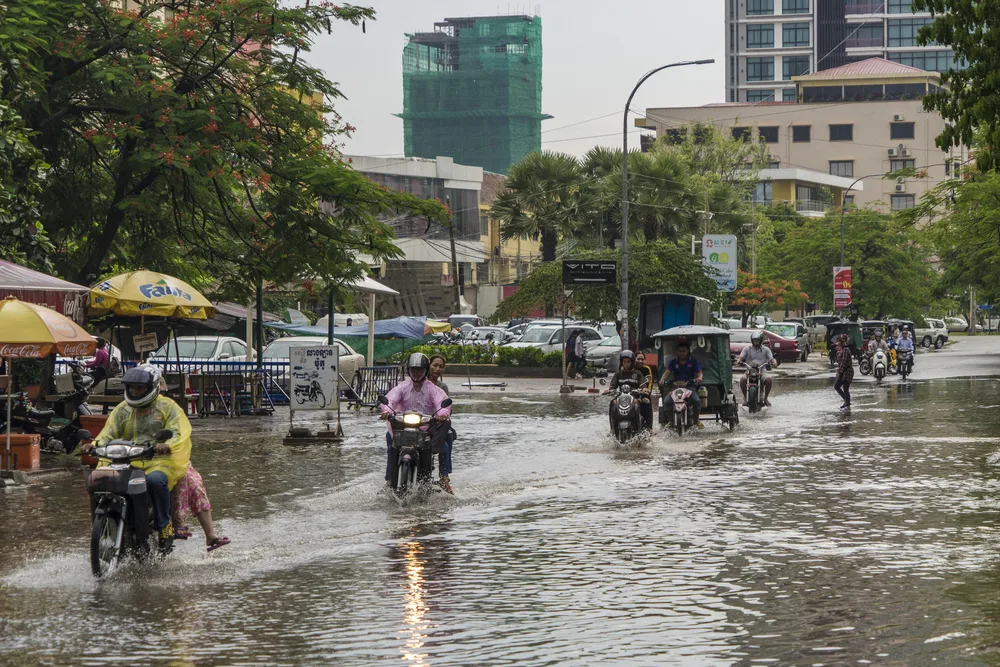
Phnom Penh, Cambodia – Jul 5 2016: Flooding from afternoon thunderstorms in Phnom Penh city/Glen Photo/Shutterstock
Being a year-round destination means you can always go to Cambodia and find suitable activities and attractions that correspond to the current season.
That said, if we really had to choose when not to go, we’d stick with the country’s southwest monsoon period, which lasts from mid-May through early October.
The rain can impact your itinerary in many ways. For instance, if you’re traveling between cities such as Siem Reap, Battambang, Phnom Penh, or other villages, flooding is more than common, so you may need to change your travel plans on the spot.
What’s more, tourism numbers surge, as July and August are a period of annual school holidays for the majority of US and European families.
Younger backpackers are also quite frequent, thanks to their university holidays. We already covered most months in terms of temperatures, so you know what to expect.
We’ll just add that July has hot temperatures fluctuating between 90.5°F and 76.5°F, and then August sees temperatures varying between 90.5°F and 76.3°F. While the monsoon season may be unpleasant if you can’t stand wet weather, it has its perks too.
The scenery is iconic, and the countryside is stunningly green and abundant. Throughout the day, there are windows of sunlight and clear skies, so going during this period can still be worth it.
Sightseeing is possible in between rainy sessions, and this is one of the best times to visit important landmarks such as the Angkor Wat or Phnom Penh’s Royal Palace. One look at these magnificent landmarks, and all the Cambodian rain will lose its relevance and power over you.
Things to Consider
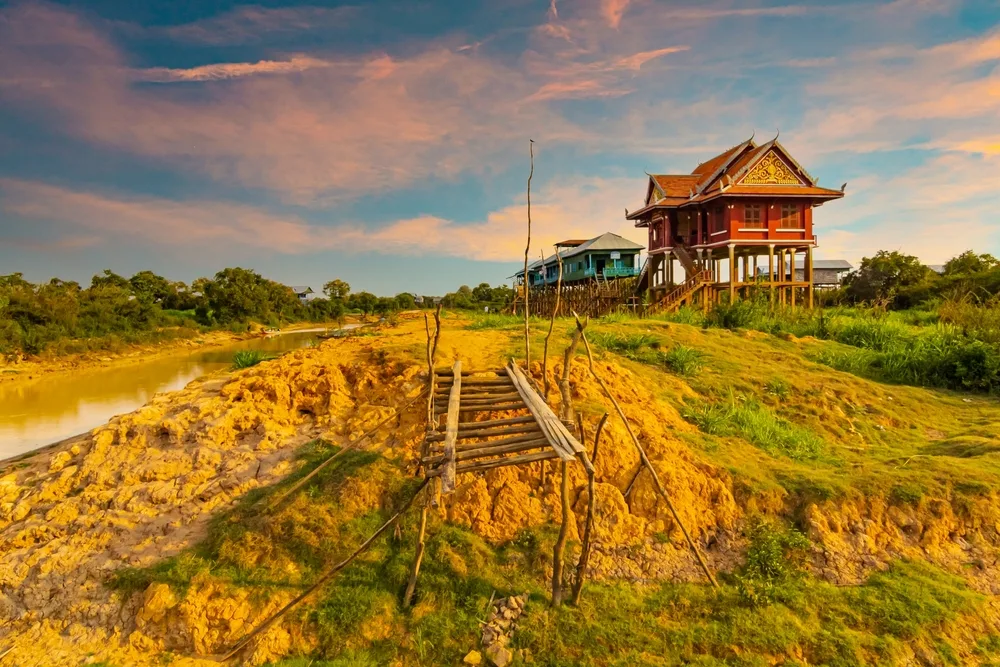
Kadagan/Shutterstock
While visiting Cambodia is safe overall, you can ensure that your trip is even safer and smoother by taking into account the following pieces of information:
- The country is at a high risk of Zika virus transmission and mosquito-borne diseases such as dengue fever.
- Get informed about the potential dress code before you visit specific places. For example, you mustn’t wear shorts or skirts above the knee or blouses/tops that are shoulder-revealing when you visit Angkor Wat.
- While there are no laws that prevent LGBT sexual activities, public opinions may be somewhat mixed.
- Caves, waterfalls, and lakes are especially prone to flooding during the country’s rainy season.
- With a plethora of active landmines scattered across the country to this day, sticking to the main routes instead of wandering is more than advisable.
- Not all ATMs accept all foreign cards, so do your research before you travel (we suggest checking with your banks for more accurate information).
Frequently Asked Questions
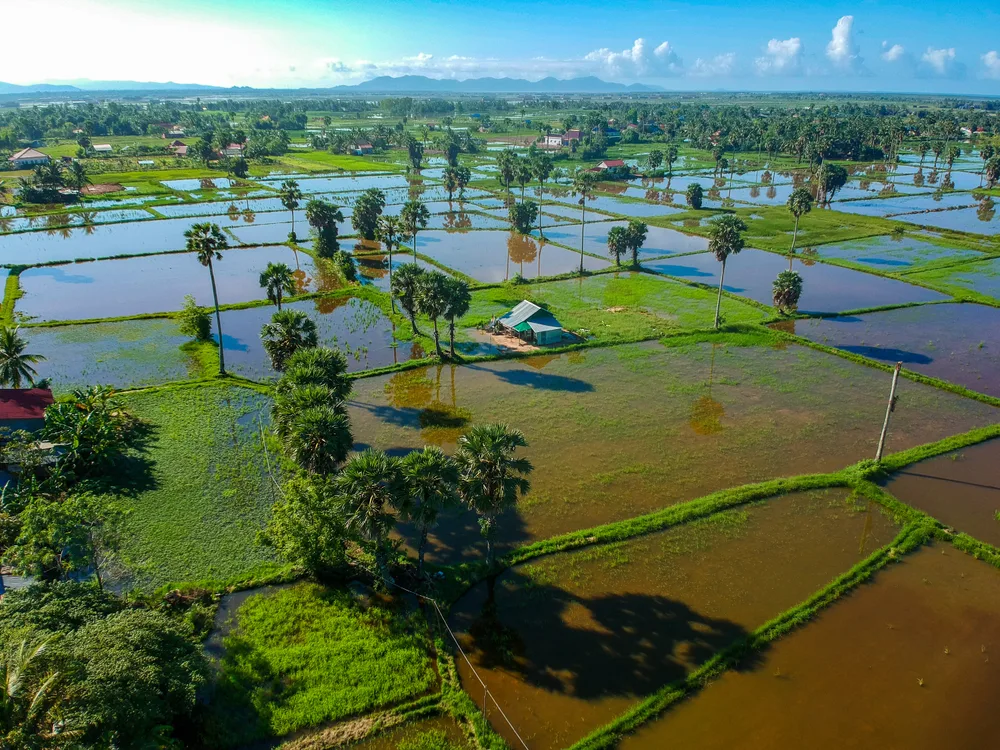
Pierre06/Shutterstock
Still have questions about the best time to visit Cambodia? We’ve got the answers:
When is the best time to visit Cambodia for pleasant weather?
The best time to visit Cambodia for pleasant weather is during the dry season, which falls between November and April, offering sunny days and less rainfall.
How is the weather in Cambodia during the rainy season?
Cambodia experiences its rainy season from May to October, with heavy rainfall, high humidity, and the possibility of flooding in some areas, making it less ideal for travel.
When is the peak tourist season in Cambodia?
The peak tourist season in Cambodia is during the dry season, particularly from November to February when the weather is pleasant, and many tourists visit the country to explore its temples and natural beauty.
What is the cheapest time to visit Cambodia?
The wet season, from May to October, offers lower prices for accommodations and tours, making it a more budget-friendly time to visit Cambodia, although you should be prepared for rain.
So, What’s the Best Time to Visit Cambodia?
Since we covered a lot of information in this guide, it’s best to wrap things up by sharing the most relevant details yet again:
On the whole, the best time to visit Cambodia is during the dry season, that is, anytime from November to April. The weather allows for a plethora of activities, but prices can quickly soar, especially if you go during the festive period.
Ultimately, here’s the thing: it’s not about the weather, the budget (ok, maybe up to a point), or the crowds — it’s what you make of your stay.
So make it your best one yet!



